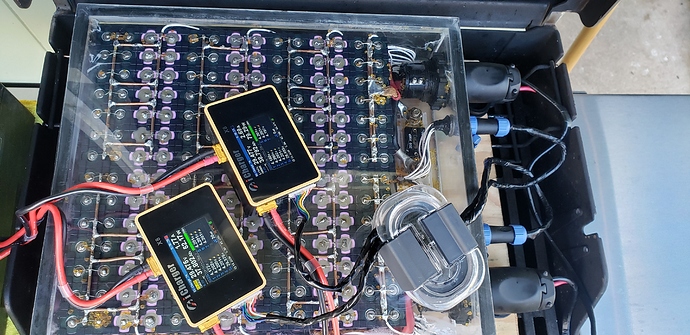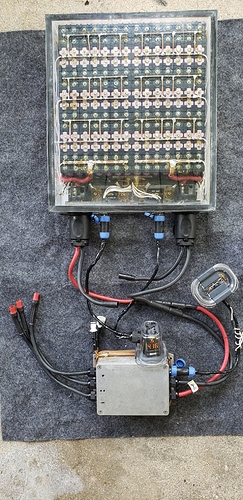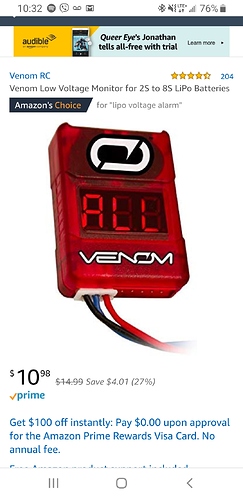I’m deep into my builds of two boards based on Pacificmeister’s design. I’m at the point where I need to select 18650s to build the battery packs. What’s the battery that you are currently working with? What do you like about it?
Hi, for the first board, I bought samsung 25r from nkon. No problem till yet. Now for the second and third build, I choose samsung 30q. This batteries are on the way now. I selected this based on the battery pack size. First it was 50Ah 12S, but now I build only 45Ah 12S.
Samsung 30Q 14s14p 42ah 56v
1h15min ride time.

Hi Au92,
i build 2x 6s10p with samsung 30q. great choice i think. with these 30Ah i get about 45min flight time. no problems in around 10-15 working hours
Go Samsung 30Q best performance to weight ratio and super reliable.
30Q is a great option if you don’t care for cycle life, because it is disastrous compared to similar cells. It is rated for only 250 cycles at 100%DoD down to 70% initial capacity. And it is known to degrade quickly after around 500 cycles and ultimately die. Other cells have a significantly flatter cycle life curve and only die very gracefully if at all.
On the other hand 250-500 cycles may be plenty for this application and until this cell dies it is able to punch pretty hard.
The 250 cycle rating is if you draw 15amps continuous from 4.2v down to 2.5v. Doing this causes the cell to get really hot. This is why the life is short.
My pack is 14s14p and I foil at an average amp draw of 30a. So, 30 ÷ 14 = 2.14amps per cell. My pack barely even gets warm.
If you keep the load per cell low these cells will last 1000s of cycles with minimal reduction in capacity.
It’s amazing this cell can handle 250 cycles at a 15a continuous draw considering the cell gets up to it’s 250 cycle rated temp of 140°F (60°F).
I tested the cells at 10a continuous discharge and they got too hot to touch, but well within the manufacturer specifications. It is this heat that limits cycle life. Run your cells where they stay cool and they will last forever (1000s of cycles).
![]()
My battery build:
You are right, that is a pretty hefty discharge for that cycle test and I wasn’t fully aware of that. Most datasheets use 1C or 0.5C.
However, the 30q is known to have a sudden death after around 500 cycles and the observation has been made that it makes almost no difference at what rate you discharge this cell or how deep the DoD is. It will have about the same loss in capacity in the end and it will die no matter what. Thats what I read over and over again at endless sphere.
That’s not true. Post some links so I can see these claims with my own eyes. I’d like to also see what the application was.
This battery was marketed as able to handle 15 amps continuous, and up to 25 amps as long as temperature is kept below 75°C.
The eskate community and several other groups who use this cell do not run enough cells in parallel. Because of this, each cell is repeatedly discharged at, and in excess of is limits.
The eskate guys do 12s4p packs and kick this batteries ass with over 100 amp discharge current. That’s over 25 amps a cell. Even with this abuse these packs last two years with this type of daily treatment!
Guys like to bad-mouth these cells in hopes the sales drop off and the price comes down. So, some of that is going on too. 


Also, many cheap BMS’s do not adequately protect the cells. It is normal to see cells over 4.2v while charging. 4.25 is too high. This damages the cell further.

I have been very happy with my 30Q cells. 14S12P.
I don’t find all references right now, but padja is repeating this over and over and he seems to know his stuff. He’s doing a lot of cycle and discharge tests.
I was able to get a great deal on some Sony VTC6 cells (14s14p) and they have been great so far. I paired that with a smart BMS from AliExpress and it’s a solid set up! I’m monitoring charging and discharging from my phone. Also, the BMS doesn’t get hot on discharge.
I have done some research on the subject.
Looks like lithium ion batteries on the whole are designed to withstand high amp loads or long cycle life.
At the moment, with lithium ion cell technology it’s a trade-off. You can’t have both. What @Benjo is saying about the 30q cells is true in the sense that all high amp draw cells have 250-500 cycle life expectancy. V.S. cells designed for long life that can only handle low amp draws (1-2amps) can achieve a 1,000 cycles.
This being said, cycle life is calculated by a capacity reduction of 20%. The battery continuous to function with 80% capacity remaining, and higher internal resistance. So, they can’t supply the same amp loads. But, in a 14p configuration each cell only needs to supply a 2 amp load, the pack will not suffer sudden death. It will continue to work as the capacity steadily falls off to it’s death.
I have seen no proof that the Samsung 30Q is any worse the the VT6 or any of the cells from this category.

It is all about cooling! Of you can keep the pack not higher than 25C during high discharge, you can except the best life time and avoid potential failures. If cant do active or passive cooling, Or your bms is not communicating SOP ( state of power based on temperature and state of charge) to motor controller, One thing that can help a lot is to make the cells thermally coupled to each other as a single mass, this will give better heat dissipation opportunity and reduce chance of individual cells going bad incase there are stressed cells due to tolerance in welding or internal resistance
Thermally coupled together is the opposite of what I do. It’s interesting to see people’s different opinions of what to do. I find these discussions are helpful. Makes me think about how I do things, and forces me to read up on things. 

IMHO I think the cells should be spaced apart. Thermally isolated from each other. If one cell thermally runs away it won’t cause a chain reaction of thermal runaways.
Even though our packs are sealed in a box with no air flow it’s still better to have air surrounding each cell because this air considerably cooler then the other cells. Each cell will cool better this way.
But, nothing keeps the cells cool like reducing the amp load on the cells. So, run as many parallel as you can.
But, as limited on space as we are, I think it is acceptable for cells to be touching each other, however my opinion is that these cells won’t cool as well, and have a slightly higher risk of thermal runaway. This should be taken into account. And may require additional cells in parallel as necessary to keep the pack cool.
And you guys already know about my pack build with individual cell fuse wires for added safety. I’m about a dozen cycles in and all is well!

Thermally coupled together is what I do, but I had no choice because I had no space. I thought it was probably not good. I would like to believe its good.
@Flightjunkie
Do some more research. I had to run some thermal simulation of the packs while back at my previous job in a close system as these packs, when a cell goes in to thermal runaways that space doesn’t help and cell gets hot much faster. As a result your limited number of bms temperature sensors will fail to detect thermal failure call to shutdown due to high temp. When cells goes to thermal run away individually, that space doesn’t help and neighbor cells get the hit. Versus a single thermal mass which all cells balance each other and none of them runs toward hell fast, so bms can detect thermal issue and shut down much sooner than thermal runway to happen. I also ran another simulation on cells with plastic wraps and cells that their wraps has been ripped off. Result was much better thermal dissipation
I can see the logic in thermally connecting the cells if they are being thermally monitored by the BMS.
And yes, if the pack has no other thermal runaway protection, thermally connecting cells is probably the safest way to go, even if it results in hotter cells under normal operating conditions. But, at 14p each cell only has a 2 amp load so it really doesn’t matter much either way. They should hardly get warm.
I don’t use a thermal monitoring BMS. My design relies on the fuse wire melting and isolating the problem cell before thermal runaway. I only have a individual cell low voltage alarm set to 3.0v.
Good idea removing the wrap. I bet they cool better without it.
Great discussion. It’s good to hear how others do things. I’m still learning as I go.

What ist inside from the two smal transparent plasic boxes?



